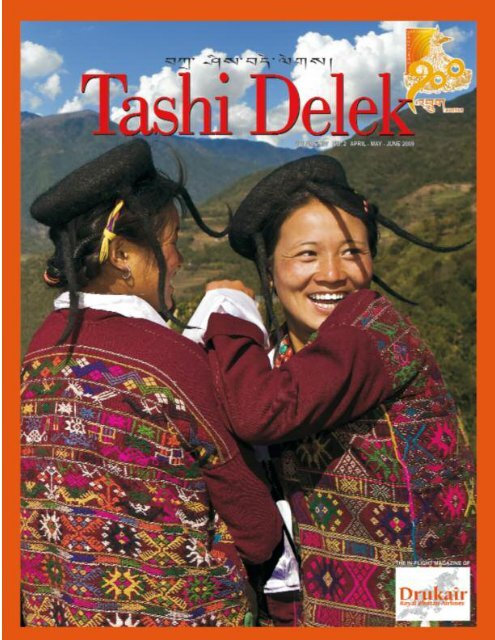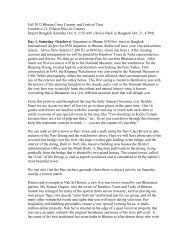Tashi Delek Inflight Magazine - Rainbow Photo Tours Bhutan
Tashi Delek Inflight Magazine - Rainbow Photo Tours Bhutan
Tashi Delek Inflight Magazine - Rainbow Photo Tours Bhutan
- No tags were found...
You also want an ePaper? Increase the reach of your titles
YUMPU automatically turns print PDFs into web optimized ePapers that Google loves.
Volume XIV, No. 2, April - May - June 2009<br />
<strong>Tashi</strong> <strong>Delek</strong> is an auspicious and versatile <strong>Bhutan</strong>ese<br />
expression. It encompassing a number of meanings such<br />
as: wishing you well, good wishes, congratulations,<br />
cheers, good luck, and so on.<br />
Tandin Jamso - Chief Executive Officer<br />
Bharati Narasimhan - Editor<br />
For editorial, advertising, circulation and<br />
subscription enquiries, please contact:<br />
Tshering Penjore - Dy. General Manager (Commercial)<br />
E-mail: khadel@druknet.bt<br />
Sonam Yangchen - Sr. Officer (Marketing &<br />
Commercial Planning)<br />
E-mail: sonamyangchen@drukair.com.bt<br />
Druk Air Corporation Limited<br />
H.Q. Paro, <strong>Bhutan</strong>.<br />
Tel.: +975 (8) 272634; Fax: +975 (8) 271861<br />
E-mail: drukair@druknet.bt<br />
12<br />
Rajesh Chhetri - Art Director<br />
Gunjan Sabikhi - General Manager (Marketing)<br />
Abhinav Malhotra - Manager (Marketing)<br />
Geetika Pathak - Manager (Advertising)<br />
Manish Mangla - Asstt. Manager (Marketing)<br />
Anil Kharbanda - Production Manager<br />
Head Office: Durga Das Publications<br />
72, Todarmal Road, New Delhi - 110001, India.<br />
Tel.: 91 11 23716318; Fax: +91 11 23351503<br />
E-mail: tashidelek@ddppl.com<br />
Mumbai Office: E-mail: mumbai@ddppl.com<br />
Middle East Office: E-mail: uae@ddppl.com<br />
© Durga Das Publications<br />
<strong>Tashi</strong> <strong>Delek</strong>, a publication of Druk Air Corporation Limited<br />
is produced and published by Rupali Narasimhan of<br />
Durga Das Publications. Views expressed in <strong>Tashi</strong> <strong>Delek</strong><br />
are not necessarily those of Druk Air Corporation Limited<br />
and/or of Durga Das Publications.<br />
All information in <strong>Tashi</strong> <strong>Delek</strong> is derived from sources which<br />
we consider reliable. and is passed on to our readers<br />
without any responsibility on our part. Similarly,<br />
opinions/views expressed by third parties in abstract and/or<br />
in interviews are not necessarily shared by Drukair and/or<br />
Durga Das Publications.<br />
Any material appearing in <strong>Tashi</strong> <strong>Delek</strong> cannot be<br />
reproduced/stored in whole or in part without prior<br />
permission of the Publisher in writing.<br />
The Publisher reserves the right to edit, rewrite or<br />
reproduce articles according to the requirement of the<br />
publication. The publisher assumes no responsibility for<br />
returning any material nor is she responsible for material<br />
lost or damaged in transit.<br />
Most of the photographs, information, etc. are taken from<br />
different sources. If inadvertently we have violated any<br />
copyright, we would apologise for that. In our next issue.<br />
Jurisdiction for all disputes in New Delhi only.<br />
Durga Das Publications.<br />
72, Todarmal Road, New Delhi - 110001, India.<br />
Tel.: +91 11 23731917, 23710793; Fax: +91 11 23351503<br />
E-mail: tashidelek@ddppl.com<br />
Printed by: Cirrus Graphics Pvt. Ltd.,<br />
B-261 Naraina Industrial Area, Phase-I,<br />
New Delhi – 110028, (India)<br />
17<br />
contents<br />
12 Spiritual coronation of the<br />
Druk Gyalpo<br />
17 The Domkhar Drup<br />
27<br />
The Grand Annual Festival of Domkhar Village<br />
33<br />
22 Lemon grass and temples<br />
27 A technical feat<br />
Reconstruction of Punakha Dzong Bazam<br />
33 A trip to Bumthang<br />
40 Take two steps back for the Chillip<br />
46 Yak - the camel of the snow<br />
52 Duty Free<br />
Cover picture courtesy: Robin Smillie
The Domkhar Drup<br />
The Grand Annual Festival of Domkhar Village<br />
Dressing room<br />
“You have killed many yaks,” yells a soldier of Yamaraja as he chases a<br />
festival dancer dressed like a monkey through the crowd. “You have killed<br />
fish and chickens and cows to fill your belly and you<br />
must now answer to<br />
The Lord of Death!”<br />
Breaking away from his<br />
Masks<br />
would-be captor, the<br />
sinner climbs a tree while<br />
the crowd below in the<br />
small and intimate<br />
courtyard of the<br />
Domkhar temple laugh<br />
at his antics.<br />
April – May – June 2009<br />
TASHIDELEK<br />
17
Th Domkhar<br />
Drup<br />
Death mask<br />
Thus begins my favourite masked<br />
dance of the Domkhar Drup, a<br />
Buddhist festival held every year<br />
on the auspicious date that<br />
coincides with the death<br />
ceremony of Zhadrung Kuchoe--the 10th day<br />
of the 3rd month of the <strong>Bhutan</strong>ese calendar.<br />
The festival is held in the heart of Domkhar<br />
village, a cluster of 30 farming households in<br />
Chumme valley, one of the four valleys that<br />
make up the Bumthang district in central<br />
<strong>Bhutan</strong>.<br />
<strong>Bhutan</strong>ese mask dance festivals are held<br />
every year in most major villages to honour<br />
Buddhist heroes and vilify demons. The<br />
sacred dances and lyrics convey moral<br />
messages and promote understanding by reenacting<br />
Vajrayana Buddhist history. They<br />
have a deep spiritual impact on those believers<br />
who witness them. Using precise and<br />
complicated choreography passed down<br />
through the centuries by master performers,<br />
dancers of the Domkhar Drup perform the<br />
iconic Black Hat Dance, the Dance of the<br />
Heroes, the Dance of the Lord of Death and<br />
several others.<br />
Every costume, mask, and utensil has<br />
symbolic meaning, from the lion-headed<br />
dancer holding an iron chain that manifests<br />
the bond of love, to the snake-headed dancer<br />
The Temple at Domkhar<br />
The Domkhar Lhakang<br />
(meaning temple) was built by the<br />
villagers of Domkhar and is<br />
maintained by them with<br />
donations coming mostly from the<br />
locals who sell agricultural products<br />
to raise funds. The Domkhar<br />
Festival is supported entirely by<br />
voluntary service and contributions<br />
from those who attend it. The<br />
underlying theme of the festival is<br />
to promote Buddhism, maintain<br />
local tradition and appease village<br />
and family deities.<br />
18 TASHIDELEK April – May – June 2009
Festival Etiquette<br />
Always be considerate and mindful that you<br />
are an invited guest. These ancient religious<br />
festivals are for the <strong>Bhutan</strong>ese people and not for<br />
a tourist’s frivolity. I’ve witnessed rude behaviour<br />
at festivals, such as a film crew with sound<br />
booms walking in amongst the dancers sticking<br />
video cameras in their faces, causing them to<br />
change their centuries-old choreography and walk<br />
around the cameraman. At one festival, I saw a<br />
foreign visitor dancing the hokey pokey on the<br />
cobblestones with the masked dancers. At the<br />
smaller more intimate festivals like the Domkhar<br />
Drup and the Ura Yakchoe where you are seated<br />
in a small courtyard, be mindful not to block the<br />
view of villagers. Always keep in mind that the<br />
<strong>Bhutan</strong>ese people are very shy and would<br />
probably never tell you that you are committing<br />
a cultural faux pas, so you should always consult<br />
your guide before entering the temple or moving<br />
about the courtyard.<br />
Try to relax and enjoy the moment, and<br />
don’t forget to memorise the faces of the deities<br />
because you never know, you may meet them<br />
again some day.<br />
Courtyard<br />
holding a mirror that reflects all deeds,<br />
virtuous and sinful.<br />
I confess to not having the religious<br />
background to comprehend the deep<br />
philosophical and moral meanings of<br />
these masked dances, but I will try to<br />
give the general meaning of my favourite<br />
Domkhar Festival dance, the Dance of<br />
the Lord of Death.<br />
The Domkhar<br />
Drup<br />
First introduced by Terton Karma<br />
Lingpa, the famous treasure revealer of<br />
the fourth century, this dance is an<br />
elaborate trial known to the <strong>Bhutan</strong>ese as<br />
the Raksha Mangcham. The Tibetan<br />
word bardo means literally "intermediate<br />
state of consciousness" but is sometimes<br />
translated as “transitional state” or “inbetween<br />
state” — the time between death<br />
April – May – June 2009<br />
TASHIDELEK<br />
19
The Domkhar<br />
Drup<br />
Atsara! Jesters of the Himalayas<br />
While the dancing masked clowns may appear to be nothing but buffoons<br />
and tricksters that constantly annoy the crowd and dancers with their wooden<br />
phallic and vulgar antics, the Atsaras play several important roles at Buddhist<br />
masked festivals. During the dances they are costume repairmen on the fly,<br />
tucking in the errant sash and retying the cloth knots that hold a heavy carved<br />
wooden masks tight to a dancer’s face. In his colourful and patchwork tunic<br />
and pajamas, the Atsara sometimes makes a fool of himself by mocking a<br />
dancer with grotesque imitation of the dancer’s expert step, all the while<br />
reaching in to the serious business of retying a knot. They are beggars that<br />
roam the crowd, seeking donations to help defray festival costs, cajoling those<br />
who give only a few pennies, urging a deeper dig into the pocket for the<br />
preservation of festival masks and food for the dancers. I once saw an Atsara<br />
take a small donation from an amused American woman and then try to<br />
embarrass her by saying, “I am an American too, and I know George Bush.”<br />
Waving his wooden phallic in the air he yelled, “Mine is bigger than his!”<br />
Then to the roar of the approving crowd he approached again and with a<br />
currency note worth a few pennies folded over on the end of the phallic said,<br />
“Do you have something bigger”<br />
The Atsaras must know every dance step because they are cultural guides<br />
who explain the meaning of the dances and characters, even going so far as to<br />
openly and sarcastically correct a dancer if there is a misstep. Lastly, and<br />
probably most important, they are goofy entertainers who break the tension of<br />
an otherwise formal festival.<br />
Inside the dressing room<br />
Monkey<br />
and the next life. Immediately after his death and during bardo, a sinner<br />
is chased and captured and brought before the court of Yamaraja, a<br />
manifestation of the Buddha known as the Lord of Death, to face<br />
judgment for his sins. Yamaraja’s retinue is made up of many spirits,<br />
gods and ghosts, including an ox-headed minister of justice, a hog-headed<br />
record keeper who records the sinner’s lifetime of good and evil deeds,<br />
and a bear-headed dancer that carries a noose to represent the need to<br />
eliminate the sinner’s selfishness.<br />
One of the many important purposes of this masked dance is to<br />
show the living humans who witness it, what each spirit and god looks<br />
like, so that during the afterlife the deceased would recognise and<br />
understand the different roles played by each. Then by faith, learned and<br />
re-learned during a lifetime of attending the festival, the believer achieves<br />
a happier stage of life in the Hereafter, be it returning to life on earth by<br />
way of reincarnation, or better yet, moving on to Nirvana where one is<br />
freed from suffering and the never-ending cycle of rebirth.<br />
Text & <strong>Photo</strong>graphs: Robin Smillie<br />
The author is the president of www.rainbowphototours.com<br />
based in Tampa, Florida<br />
20<br />
TASHIDELEK April – May – June 2009





